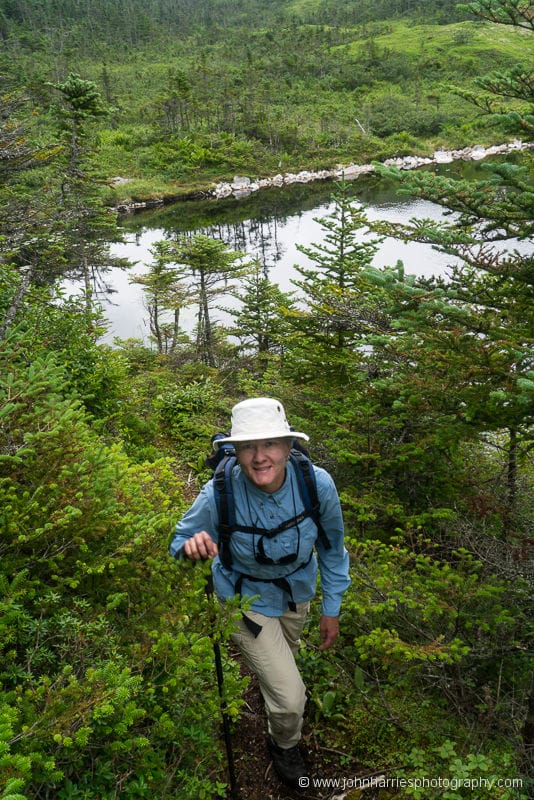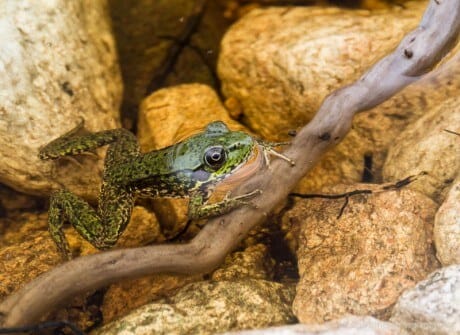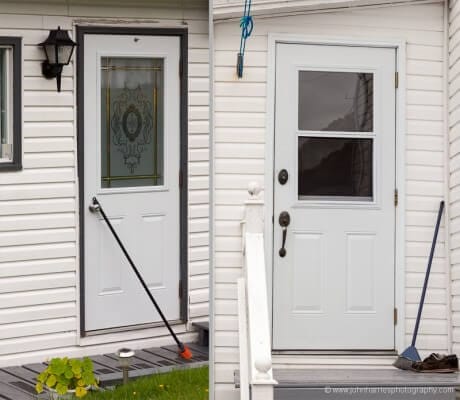
Herman Fudge, self-proclaimed welcome wagon and traffic control for McCallum, a nonroad-served village nestled in among a group of islands at the mouth of Hermitage Bay, stands on the floating dock and waves us in. Grabbing the springline, he holds it while I get ashore. Before wandering off he points out the store near the dock and the church on the hill and says he’ll see us around.
Herman meets every boat, every ferry, and every helicopter that comes to McCallum. He waves them all in and points to their landing spot. He likes the one ferry’s crew as they let him put the lines on the bollards but the other crew isn’t so nice, he reports. Herman has a role in McCallum; I wonder what he would do if required to move somewhere else?
Our next contact with the residents of McCallum is Terry, McCallum’s harbourmaster, who drops by a few minutes after Herman ambles off. We’ve heard a lot about Terry and his fiancée Linda from our sailing friends Doug and Dale Bruce, who have visited here numerous times on their boat Bluewater. Over a drink of rum, Terry tells us that though he’s been a fisherman for 35 years, fishing from a speedboat, he’s having hell to make a living. Strangely, the price of cod has bottomed out, despite its scarcity, making it hardly worthwhile to go out anymore, he says, what with the price of bait, gas for the outboard, and wear and tear on the gear.

Terry reports that McCallum has about 60 people in winter (a few more in summer), and that the youngest child in the community is entering Grade One this fall. He says that when there are no more children in the school the government will approach the community about closing up so, unless things change, McCallum has 12 years to go. But the older people don’t want to talk about moving. He says that when Pushthrough, a few miles further into Hermitage Bay, was resettled 20 years ago, most of the older people died of broken hearts within a year.

On a positive note, Terry says there is talk that they will soon be getting high-speed satellite internet. To date, the so-called “high-speed” internet available has been no better than dial-up. Maybe real high-speed internet will attract young people to the village.


The next day John and I strike off along the boardwalk past the school, medical clinic and incinerator, and follow an enticing footpath into the woods (no red and white painted boardwalks here!). It takes us up a steep cliff to a flat plateau and continues on to a small pond. We follow a tiny trail around the pond edge, serenaded by the guttural honks and watery plops of startled frogs. On the other side of the pond we come across two homemade nets, used for pond hockey in the winter.

We follow the trail to the edge of a huge lake and then turn back on a loop towards the village. At the edge of the clifftop above the town we stop to munch power bars and take a photo of Morgan’s Cloud far below. On our way back down we come across a cluster of small sheds on a hilltop just in back of the village, which Terry tells us house snowmobiles, as the snow is better up there than down at sea level.

After our hike we stop off at Terry and Linda’s for tea. Somehow it comes up that the brooms we have noticed on everyone’s doorstep aren’t just to keep the sidewalks swept. In a community where no one locks their doors and tradition mandates that you can just walk into your neighbour’s house without knocking, people have come up with an ingenious form of community sign language: If the broom is angled across the door, resting on the doorknob, you are either away or want privacy. If the broom is standing upright in the corner people are free to stop by.
The next day the wind is in the east, so it’s time to make some westing. Just before we cast off, Terry shows up with a bag of fillets from cod that he caught that morning. Once again we are recipients of the warm hospitality and generosity of Newfoundlanders. We are truly blessed.

What a beautiful, if sad, place. After reading your recent posts on these isolated communities, I’m a bit heart-broken myself. Part of me thinks “I’m going to move there and help. I know I could find something to sustain a community like that.” Then I immediately remind myself of the reality, that I’d just be an interloper, and these communities know best how to help themselves. The engagement by “Western” society in the Pacific islands is certainly a good example of the pitfalls of social/community engineering. Thank you for the great insights and photos!
Makes you wonder if progress really is progress, crowding people into towns and cities vs self sufficiency. Glad you are documenting this history of a wonderful place.
Thanks for this beautiful pictures and insights.
It sadens me to think that until i may get a chance to go there, they may all be gone. Somehow most of this villages look happier to me then our big towns.
Hi Phyllis and John — One of our mementos of our own visit to McCallum in August 2011 is a picture of my wife — also Phyllis — and Herman taken just after they had returned from his guided tour of the town. When we get back to our home in Blue Hill, ME (currently in Bermuda), we will try to upload a copy to you. Emphasis on “try”.
W
this is a timely post ’cause maybe you can give me your thoughts on what i just exeperienced please…now on the hook at the main anchorage in anegada after making the obviously uncomplicated short run from n gorda sound… except when it came time to furl the genny in the normal manner off the wind (roughly 15 knot sse breeze in about 4 ft seas) to enter the channel the furler seemed to jamb…still way off the wind i made my way to the bow (just me, no crew) with help from the autopilot and found nothing to explain the stubborn furler…went back to the cockpit and resorted to help from the winch…all that did was test the breaking strength of the furling line and who knows what else…by now i was too close to the coral heads to mess with the thing any longer , fired up the iron genny and put up with the slatting sail long enough to make deeper water and drop the main…by now the headsail was all the way unfurled forcing me to find enough sea room to drop back off the wind again…this time the furler worked as if there was never a problem in the first place…while i have read about such situations and the potential for major problems associated with them this has never happened to me before in my 20+ years under sail including several thousand miles blue water in the atlantic between ct and virgin gorda twice…any idea what might have happened please ?
richard s.
s/v lakota (she’s brand new dufour 43 and we are still becoming acquainted)
Hi Richard,
Sounds like a partial halyard wrap to me.
See this post for the fix (slideshow at bottom, fourth shot showing deflector.)
it happened again, but this time thanks to your expertise i knew what to look for up at the bow again…sure enough…halyard wrap…the spinnaker halyard to be specific…it had a little play in tension so i tightened it at the mast enough to allow the furler to do its work, and then i tightened it for real with the cockpit winch locking it down in its clamp…many thanks for your help as i was again in a spot where that sail needed to furl…i’m going to see how this does before i start thinking about the nice deflector you have as that will entail retrofitting, but i’ll do it if this doesn’t fix the problem…you just doubled the amount of the christmas contribution i am budgeting and look for it early…again, many thanks…the only credit i might take is that i believe i stayed relatively calm in both situations and focused on doing my best to remedy them by exercising my grey matter which, i might add, thankfully led me to run it by you immediately after the first incident
richard s.
s/v lakota, virgin gorda
Hi Richard,
Glad we could help.
We always run the spare halyards back to the mast, when sailing, which stops them wrapping.
Phylis,
Thanks for yet another carefully observed and beautifully written piece. I’m not sure when I will be able to be there, but I am now sure that it’s an area that I would love to visit – and hopefully whilst some of these great little communities are still there to enjoy….
Paul
Cindy thanks you for the picture of the Newfie frog.
Yes, Herman Fudge is an essential part of the McCallum experience. He is a wonderful person who is truly blessed to be able to live and prosper in McCallum. Our best wishes go out to everyone of McCallum who always make us feel welcome. Thank you. We look forward to our next visit.
Philip & Sharon Merlier Cape Dory 36 – “Evergreen”
Nice article….Haven’t been back since “93”, will go back soon for visit to show my kids where I grew up, before this community no longer exist. I have great memories of my home town.
D
the above mentioned herman fudge will turn 50 on september 17, after a big party in his honour on the 14th. i share this in the event a sailor or two wish to send him a birthday card at box #41, mccallum, newfoundland A0H 2J0. thanks for your consideration.
Hello there, There’s no doubt that your blog might be having internet browser compatibility problems.
Whenever I take a look at your site in Safari, it looks fine however, if opening in IE,
it has some overlapping issues. I simply wanted
to provide you with a quick heads up! Other than that, great website!
Hi Phylis and John, I loved your snapshot of McCallum. Left there 7/24/11 only to be dismasted that afternoon. I am glad to hear that Terry is still around and his life seems to be getting back to normal. I hope to get back there, Hermitage Cove too, before it is all gone.
Denis
I am the last of my immediate family and my plan is to visit Newfoundland this year and go to the places where my parents were born. McCallum is the place my mother was from. Her maiden name was Willman but a census I saw online has it listed as Wilmot(t). I’m really looking forward to my visit and was wondering if you could tell me about anything in particular that I should check out while I’m there?
Hi Phyllis,
I’ve been looking through a bunch of your Newfoundland posts… Lovely writing.
It seems that most of your cruising there has been on the southern coast. I’m wondering how it compares to the east coast – Notre-Dame and Bonavista Bays?
We have limited time this summer to cruise upto Newfoundland – expecting to arrive about August 1st and to spend a month or so – where would you recommend?
Hi Bill,
We have also spent quite a bit of time on the east coast, but it was before we were writing so much.
Hard to say that one part is better than another, it’s all good. If it were me, with just a month, I would concentrate on the south coast and leave the east for another year when I had more time.
Hi Phyllis, I just recently visited McCallum: it is indeed, a very special place in a special part of the world. I make harbor notes where I go and I thought the following might augment and update your report.
My best, Dick Stevenson, s/v Alchemy
McCallum:
Easy entry the “long” way around (ie not the shortcut). There was a free side to the floating dock which we went to. A local boat was on the other side (often fish farm workers) and the ferry wharf was empty. There are gov’t wharfs that were empty and could be used. No electricity and the water supply has been recently determined to be no good. The store was quite well stocked. There are no longer brooms at every door (a local custom where the broom is so situated as to give the message of whether visitors are welcome or not). The very friendly “Greet-er” mentioned in some accounts was not present when we moored or when the ferry arrived.
McCallum, extremely friendly to visitors, sounds like it will not choose to be resettled in the near future. Resettlement lost 4 years ago and, we were told, many of those wishing to resettle have chosen to move away so that the percentage of “stay” votes has apparently increased. However only 30 people (with 3 children) lived there this past winter. We were told that one could get a home there now for what can only be called a ridiculously low price.
Marion, the harbormaster, comes down early most evenings. Her husband, Didi, is an engineer/ mechanic and has a repair shop up the hill. The grocery store is quite well stocked.
Walking/hiking: to the S follow the boardwalk to its end. A trail starts there and goes straight to a lovely look-out bench nestled in the bush. Back a ways and just after the board walk ends there is a trail going up on the right which takes you uphill overlooking the “local knowledge” shortcut into the harbor (the shoal areas are easy to see), and then up a notch/saddle and into the interior. There you will look away from the cut and down into a depression with a forested area to cross. The “trail” leads through the forest, and then you can work your way up high to wonderful vistas and the antenna tower, a mixture of trail and easy cross-country walking. Locals deem the trails un-maintained (and they area), but we were able to follow ok. After the antenna tower you can see the cemetery and work your way down to it. Alternatively, start at the cemetery and work your way up to the antenna array and then likely backtrack as getting to the trail through the woods towards the cut would be a challenge.
The boardwalk N (to the right facing the town) was not maintained and was falling apart. It seemed to lead only to a lookout.
The middle way up through town takes you past Didi’s Repair. At the very next house on the right go across their lawn veering left (near a wood cover on the ground) where you will find a trail leading up to the snowmobile sheds (kept up there as there is better snow up higher away from the water). Or go on to the pump house and find another trail leading also to the snowmobile sheds above. (Going “too far” brings you to the dump/incinerator.) Continue past the snowmobile sheds and up to the rocky heights to the N above the town where there are meadows and ponds that are just beautiful and fabulous views down to your boat in the harbor. Trails (mostly moose and ATV trails) lead off in a couple of directions or just wander about from lookout to lookout as we did.
Hi Dick,
Thanks very much for the update. Good to hear that the village is staying viable, although sad to hear of some of the changes.